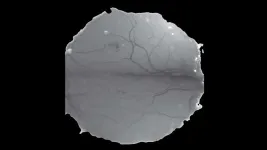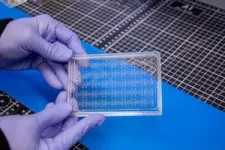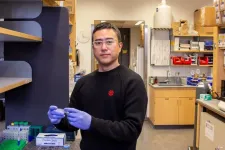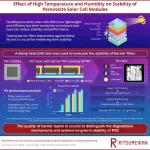(Press-News.org) Kaboom! The first time most of us hear the sound of an explosion is in the movies. Encountering the sound in the real world—even at a distance—has a profoundly different effect. Why? It’s all about context. How we react to sounds and other sensory stimuli depends on how they’re presented. We often don’t know how we’ll respond to something until we experience it. And the sensation is sometimes quite different from what we expected. So, the brain has to adjust quickly.
Cold Spring Harbor Laboratory (CSHL) Professor Florin Albeanu explains: “In nature, animals are faced with different rules of engagement. Sometimes, the same stimuli mean different things depending on context. Therefore, it’s not so unusual that you have to act on these different rules and assess what action you have to take. What are the associations that the stimulus has with certain outcomes?”
New research from Albeanu and postdoc Diego Hernandez Trejo helps explain how this works. Their findings point to never-before-seen fast-updating signals in a feedback loop between the brain’s olfactory cortex and olfactory bulb. These signals may help put odors and sounds into new contexts. The feedback loop may enable an animal’s brain to immediately adapt to changes and help the animal fine-tune its motor responses accordingly.
Hernandez Trejo and colleagues ran a series of behavioral tests to measure mice’s reactions to different smells and sounds. The mice were trained to associate rewards with one stimulus but not the other—and only for a while. Importantly, the researchers switched the rules once the mice seemed to learn them. That presented little trouble for expert mice, Albeanu says. “The animal is able to extract this change. Within a few seconds, it’s going to act in a way that is consistent with understanding. Interestingly, we observed that top-down signals, which originate in the olfactory cortex, convey information about the reward value of the stimulus to the olfactory bulb—irrespective of them being sound or odor.”
The olfactory cortex is the part of the brain that processes smell, yet it seems to take sound into account. This result tracks with another CSHL discovery, which shows how sensory cues become integrated with each other in the brain. It also raises some exciting questions.
How do reward signals emerge? Does this feedback loop also integrate sight and touch? “There’s a universe of possibilities,” Albeanu says. He’s eager to continue exploring that universe along with collaborators Andrei Ciuparu and Raul Muresan from TINS in Romania, knowing that each answer tells us more about the world we share and the perceptions that shape our understanding of it.
END
A hearing aid for … your nose?
2025-01-30
ELSE PRESS RELEASES FROM THIS DATE:
Borrowing nature’s blueprint: How scientists replicated bone marrow
2025-01-30
Hidden within our bones, marrow sustains life by producing billions of blood cells daily, from oxygen-carrying red cells to immune-boosting white cells. This vital function is often disrupted in cancer patients undergoing chemotherapy or radiation, which can damage the marrow and lead to dangerously low white cell counts, leaving patients vulnerable to infection.
Now, researchers at the University of Pennsylvania School of Engineering and Applied Science (Penn Engineering), Perelman School of Medicine (PSOM) and the Children’s Hospital of Philadelphia (CHOP) have developed a platform that emulates human marrow’s ...
Politically connected corporations received more exemptions from US tariffs on Chinese imports, study finds
2025-01-30
Research recently published in The Journal of Financial and Quantitative Analysis reveals that politically connected companies were significantly more likely to receive valuable exemptions from the tariffs imposed on U.S. imports from China during the Trump administration.
The authors, Veljko Fotak (SUNY Buffalo), Grace Lee (Fordham University), William Megginson (University of Oklahoma), and Jesus Salas, associate professor of finance (Lehigh University), found that companies that made substantial investments in political connections to Republicans prior to and during the beginning of the Trump administration were ...
Walk like a … gecko? Animal footpads inspire a polymer that sticks to ice
2025-01-30
A solution to injuries from slips and falls may be found underfoot — literally. The footpads of geckos have hydrophilic (water-loving) mechanisms that allow the little animals to easily move over moist, slick surfaces. Researchers in ACS Applied Materials & Interfaces report using silicone rubber enhanced with zirconia nanoparticles to create a gecko-inspired slip-resistant polymer. They say the material, which sticks to ice, could be incorporated into shoe soles to reduce injuries in humans.
Slips ...
Role of barrier films in maintaining the stability of perovskite solar cells
2025-01-30
Perovskite solar cells (PSCs) present a revolutionary leap in renewable energy technology with their high efficiency, lightweight, and flexible nature. But their commercial applications are often hindered by their sensitivity to environmental factors like heat and humidity.
To address this, a team of researchers led by Professor Takashi Minemoto, a Ritsumeikan Advanced Research Academy Fellow from the College of Science and Engineering, Ritsumeikan University, Japan, along with Dr. Abdurashid Mavlonov from the Research Organization of Science and Technology, Ritsumeikan University, and Dr. Akinobu Hayakawa from Sekisui Chemical Co., Ltd., recently conducted pioneering ...
New technology tracks dairy cows for improved health and productivity
2025-01-30
As dairy farmers dwindle every year, the demand for high-quality milk remains steadfast, driving a surge in dairy farming. Although this shift improves efficiency, it makes managing the health of individual cows more challenging. Effective health management has thereby become a critical issue in the dairy industry. Early detection of abnormalities, swift diagnosis, prevention of disease spread, and maintaining proper breeding cycles are essential for desirable and stable milk production.
While there are invasive methods, like using mechanical devices attached to dairy cows for health ...
Antibiotics of the future are prone to bacterial resistance
2025-01-30
Researchers from the HUN-REN Biological Research Centre, Szeged (Hungary), have made a concerning discovery about the future of antibiotics. Two recent studies, published just days apart in Nature Microbiology and Science Translational Medicine found that resistance can develop against new antibiotics even before they are widely used, compromising their effectiveness from the start. The studies focused on five critical bacterial species that cause major hospital infections and examined 18 new antibiotics, some already on the market and ...
New ‘Matchless’ grass variety yields high seed count without need for field burning
2025-01-30
PULLMAN, Wash. — A new variety of Kentucky bluegrass has been commercially released by researchers at Washington State University.
“Matchless,” developed from another bluegrass variety called “Kenblue,” offers seed growers higher yields without the harmful impacts of burning. It also provides consumers with the option of a more environmentally friendly grass.
For several decades in the 1900s, Kentucky bluegrass growers burned fields to remove stubble after harvest, reduce thatch buildup, prevent disease, and for a number ...
Propranolol may reduce ischemic stroke risk in women with migraines
2025-01-30
Research Highlights:
Propranolol, a beta blocker medication used for treating high blood pressure and preventing migraines, may lower ischemic stroke risk in women who experience migraines frequently.
In the large analysis of more than 3 million medical records, the protective effect of propranolol was stronger for ischemic stroke compared to other stroke types and in women with migraine without aura. However, it did not have the same effect on men.
Note: The study featured in this news release is a research abstract. Abstracts presented at the American Heart Association’s scientific ...
Stroke may increase risk of anxiety, depression and more in children
2025-01-30
Research Highlights:
Children who have had a stroke may be at higher risk for developing anxiety, depression and related physical symptoms such as headaches and stomach aches than their peers.
Among the study participants, the most common age for emotional challenges in young stroke survivors was around age 9.
Note: The study featured in this news release is a research abstract. Abstracts presented at the American Heart Association’s scientific meetings are not peer-reviewed, and the findings are considered preliminary until published as full manuscripts in a peer-reviewed scientific ...
Eating a Mediterranean-style diet improved brain health in study of Hispanic/Latino adults
2025-01-30
Research Highlights:
Closely following a Mediterranean-style diet — rich in fruits, vegetables, beans, olive oil and some fish and chicken — was associated with improved brain health in a study of Hispanic/Latino adults in the U.S.
The Mediterranean diet provided benefits that extended beyond heart health, researchers said.
Note: The study featured in this news release is a research abstract. Abstracts presented at the American Heart Association’s scientific meetings are not peer-reviewed, and the findings are considered preliminary until published ...






